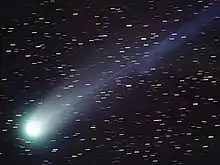16P/Brooks
16P/Brooks, also known as Brooks 2, is a periodic comet discovered by William Robert Brooks on July 7, 1889, but failed to note any motion. He was able to confirm the discovery the next morning, having seen that the comet had moved north. On August 1, 1889, the famous comet hunter Edward Emerson Barnard discovered two fragments of the comet labeled "B" and "C" located 1 and 4.5 arc minutes away. On August 2, he found another four or five, but these were no longer visible the next day. On August 4, he observed two more objects, labeled "D" and "E". "E" disappeared by the next night and "D" was gone by the next week. Around mid-month, "B" grew large and faint, finally disappearing at the beginning of September. "C" managed to survive until mid-November 1889. The apparition ended on January 13, 1891. After the discovery apparition, the comet has always been over two magnitudes fainter.
_-_comet_Brooks.jpg.webp) | |
| Discovery | |
|---|---|
| Discovered by | William Robert Brooks |
| Discovery date | 7 July 1889 |
| Designations | |
| 1889 V; 1896 VI; 1903 V; 1911 I; 1925 IX; 1932 VIII; 1939 VII; 1946 IV; 1953 V; 1960 VI; 1974 I; 1980 IX; 1987 XXIV; 1994 XXIII | |
| Orbital characteristics | |
| Epoch | 2023-02-25 |
| Aphelion | 5.439 AU |
| Perihelion | 1.879 AU |
| Semi-major axis | 3.659 AU |
| Eccentricity | 0.4864 |
| Orbital period | 6.99 yr |
| Max. orbital speed | 40 km/s (1886 Jupiter approach) 26 km/s (2028 perihelion)[1] |
| Inclination | 3.011° |
| Last perihelion | April 18, 2021[2] June 7, 2014[3][4] April 12, 2008 |
| Next perihelion | 2028-Apr-21[1] |
1886
The comet's breakup is believed to have been caused by the passage of the comet within Jupiter's Roche limit around 20 July 1886,[5][4][lower-alpha 1] when it spent two days within the orbit of Io.[lower-alpha 2]
| Date & time of closest approach |
Jupiter distance (AU) |
Sun distance (AU) |
Velocity wrt Jupiter (km/s) |
Velocity wrt Sun (km/s) |
Reference |
|---|---|---|---|---|---|
| 1886-Jul-20 22:32 | 0.001 AU (150 thousand km; 93 thousand mi; 0.39 LD) | 5.457 AU (816 million km; 507 million mi) | 41.1 | 40.1 | Horizons |
The very close approach to Jupiter in 1886 resulted in the previous perihelion distance becoming the new aphelion distance.
| Epoch | Aphelion (AD) |
Perihelion (QR) |
Period |
|---|---|---|---|
| 1865 | 14 AU[lower-alpha 3] | 5.5 AU | 31 years |
| 1889 | 5.4 AU | 1.95 AU | 7 years |
On 31 December 2016 the comet passed 0.333 AU (49.8 million km) from Jupiter and on 5 July 2053 ± 3 days it will pass about 0.26 AU (39 million km) from Jupiter.[7]
Notes
References
- "Horizons Batch for 16P/Brooks 2 (90000273) on 2028-Apr-21" (Perihelion occurs when rdot flips from negative to positive). JPL Horizons. Archived from the original on 2022-06-15. Retrieved 2022-06-15. (JPL#K212/6 Soln.date: 2022-Feb-04)
- "16P/Brooks Orbit". Minor Planet Center. Retrieved 2014-06-16.
- Syuichi Nakano (2011-11-01). "16P/Brooks 2 (NK 2146)". OAA Computing and Minor Planet Sections. Retrieved 2012-02-18.
- Kinoshita, Kazuo (2016-08-01). "16P/Brooks past, present and future orbital elements". Comet Orbit. Archived from the original on 2011-07-10. Retrieved 2023-07-19.
- "Horizons Batch for 16P/Brooks 2 (90000258) on 1886-Jul-20" (1889–1904 dataset). JPL Horizons. Archived from the original on 2023-07-20. Retrieved 2023-07-19.
- Horizons output. "Osculating Orbital Elements for 16P/Brooks (90000258)". Retrieved 2023-07-20.
- "JPL Small-Body Database Lookup: 16P/Brooks 2". Archived from the original on 2012-12-12. Retrieved 2023-07-19.
2022-01-29 last obs
External links
- Orbital simulation from JPL (Java) / Horizons Ephemeris
- 16P/Brooks 2 – Seiichi Yoshida @ aerith.net
- 16P at Kronk's Cometography

.png.webp)